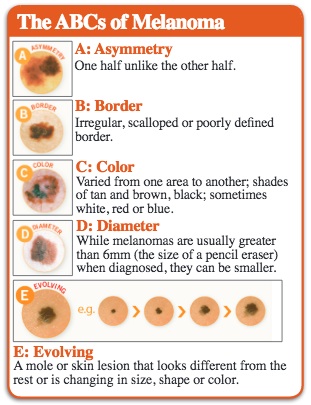By James Rousseau, MD, Board Certified Internal Medicine Physician; Center for Adult & Family Medicine
Have you ever finished showering, looked down and noticed a spot on your arm or leg that you did not remember being there before? What about the mole you have had your entire life suddenly not being the same color and larger than you remember? How many times have we heard a friend say, “Oh, that is nothing. It has been there for years.” Many of us may have had an experience similar to the one de-scribed or very similar. It is easy to brush off any concern about a spot or mole you have had your entire life suddenly changing color and shape, but this is something that a physician should examine further to be on the safe side.
What is Melanoma?
Melanoma is a serious form of skin cancer that occurs when normal cells in the skin change and grow very quickly. Melanoma can show up anywhere on your body- including unexposed areas, such as your back. Often skin cancer will present as a black or brown mole. An easy way to remember the steps to identifying an unusual mole is simply remembering your ABCs.

Follow these simple steps on a regular basis to complete a thorough skin-exam:
(1) Learn what you are looking for and refer to the ABCs as noted above for guidance.
(2) Examine your skin for any spots, moles, freckles, or skin tags you have not seen in the past or have changed in appearance. Examine entire body, front to back, left to right, elbows, forearms, upper arms, palms, backs of legs and feet, spaces between toes and soles, back and buttocks, back of neck and scalp, to complete examination.
(3) Record your spots so that you can refer back to them next time you do a skin exam.
What if I Find Something?
Call your Primary Care Physician (PCP) and schedule an appointment. Your PCP will most likely do an exam and check your skin all over your body. If the physician is concerned about a spot/mole, he/she may schedule a follow up appointment to do a minor office procedure to biopsy the area. Or the physician may refer you to a dermatologist to evaluate and/or possibly biopsy the area of suspicion.
How Can I Protect Myself?
Here are a few tips to protect your skin from overexposure to harmful ultraviolet (UV) rays:
Limit the amount of time your skin is exposed to direct sunlight. This is always the best way to reduce your chance of getting skin cancer. Generously apply a broad-spectrum, water-resistant sunscreen with a SPF of 30 or higher.
Re-apply every two hours, even when it is cloudy outside or after swimming or sweating. Many people forget that water, snow, and sand reflect harmful sunlight and can increase your chance of skin cancer.
Be sure to avoid direct sunlight between 10:00am – 4:00pm and find shade during this time.
Wear protective clothing, such as long sleeves, a wide brimmed hat and sunglasses.
Avoid tanning beds because they have harmful ultraviolet light that can cause skin cancer.
https://www.aad.org/spot-skin-cancer/learn-about-skin-cancer/detect-skin-cancer/what-to-look-for



